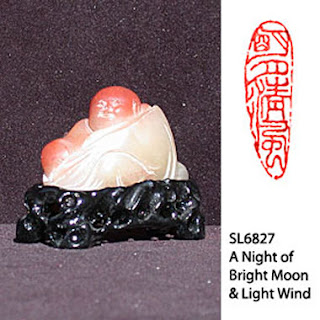Little Treasures
Artist Seals or Chops
Using the
seal as an integral part of the composition in ink painting is uniquely
Asian.
To authenticate and to show
approval of his/her work, the artist uses a personal seal in red along
with his signature. In
addition to the personal
signature and seal, most traditional Chinese brush artists use seals to
enhance their compositions.
Antiquity, artistry, and the quality of the material from which a seal is carved
determine it's value.
The seal tradition began as a way for the artist to authenticate his
work. He would sign his completed work with his brushed calligraphic signature
and then follow with a stamp of his seal (Artist Name Seal),
thereby identifying the work as his own. However, the seal soon expanded
from a name moniker to more complex self-expression as artists commissioned
special pieces to evoke ideas and emotions as well. This lead to mood seals and poetic seals such as the seal pictured above. As with many things
in China, this practice goes back to early recorded history appearing on
some of the most treasured dynastic artworks of antiquity.
In ancient China it was customary for each successive owner of a painting to add his own personal seal to that of the artist. This custom provides a valuable history of the work and accounts for the proliferation of seals found on old master paintings. In those dynastic days, only persons of great privilege, wealth, and position could own or sponsor such works of beauty.
In ancient China it was customary for each successive owner of a painting to add his own personal seal to that of the artist. This custom provides a valuable history of the work and accounts for the proliferation of seals found on old master paintings. In those dynastic days, only persons of great privilege, wealth, and position could own or sponsor such works of beauty.
For thousands of years, seal carvers have passed their specialized craft
through family lines, from father to son, across time, to give us
generation after generation of venerated carvers and remarkable, poetic
carvings. Unfortunately, as China becomes more and more modernized, this
ancient and honored skill is becoming more and more difficult to find.
Seal Paste
Cinnabar
Red seal paste, sometimes also referred to as cinnabar, is used to stamp the seal design. Many ink painting artists do not consider their artwork finished or approved by them until the seal / seals are placed on the painting or calligraphy piece.
I have an extensive personal collection of artist seals. They are works of beauty worth collecting and provide me with a lovely way of signing my work. Above are just some of the artist seals or chops that I use in my sumi-e. They translate
(from left to right):
Square = Casey
Small Round = Spring
Large Round = Be Well
Large Oval = Elegant Style
Smaller Oval = Journey into Art
Lightly press your seal into the paste several times
and, as you do, blow on the seal to help warm and soften the paste.
Always test the seal first on a piece of painting paper. If the imprint
looks good, tap the seal into the paste a few more times, and then place
it on your painting in a firm manner. Do not wiggle the seal around or
you will blur the image. Just exert firm pressure on it for a moment,
and then lift straight up.
To get a sharp image, place a magazine under your
painting before stamping. As an undersurface, a magazine offers just the
right amount of yield and support. A softer undersurface can wrinkle
the paper, while a harder undersurface could result in a poor contact.
Practice placing your seals so that they appear straight. Always
completely wipe off your seal before putting it away.
Blue Heron Arts
California, USA
California, USA
California, USA
Dragon Artworks, Ohio, USA
and Shanghai, China
and Shanghai, China
Article by: Casey Shannon
China
Seal Carving Gyoku-seki Society
Director for USA
Director of North America Branch ~ ICCPS
International Chinese Calligraphy and Ink Painting Society
国際中国書法国画家協会アメリカ支部:Ms. Casey Shannon アメリカ現代水墨画家
Copyright © Casey Shannon Studio Art. All rights reserved.






No comments:
Post a Comment